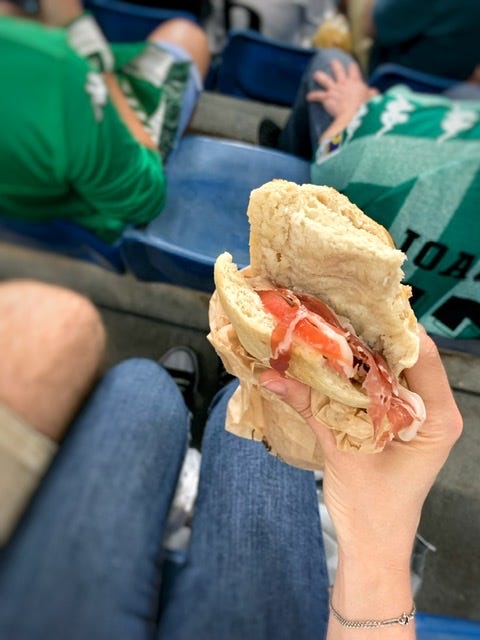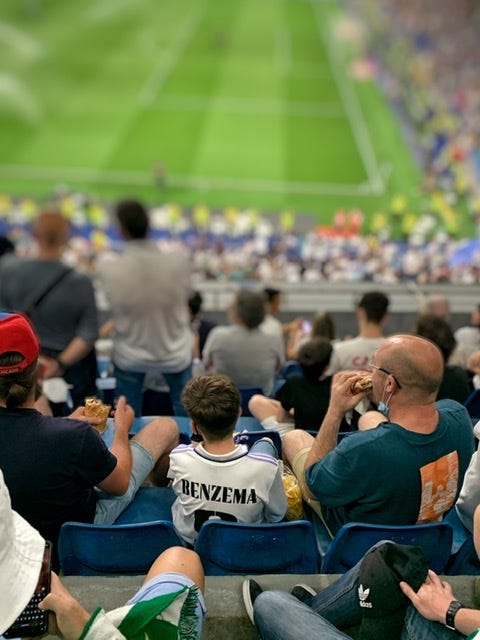I’ve never been a fan of watching sports on television. If there’s a big game and it becomes more of a social event, then I can hype myself up for it (think Super Bowl Sunday). But the truth is, my mind often wanders, and I usually end up fighting the temptation to go down some rabbit hole on Reddit about the history of Super Bowl halftime performances, or wondering if I can create a convincing dairy-free version of spinach and artichoke dip (recipes welcome!).
But in-person sporting events are a different story. When anyone here asks me if I like fútbol1, I always respond that I get bored watching it on TV, but I love going to the stadium. I’m pretty sure my friends secretly think I say that just because David is a huge Real Madrid fan, but it’s actually true. I adore the ambiente2 of the stadium: the energy you get from cheering alongside your fellow aficionados3, the high-fives and hugs when your team scores, and (of course my favorite, since it involves food) eating a bocadillo at halftime.
Bocadillos are Spain’s answer to a sandwich. The base is a crunchy baguette, and the filling options are endless. More traditional bocadillos typically star some type of meat (such as fried chorizo, jamón ibérico, or lomo4) or omelette (usually the famous tortilla de patata). Additional ingredients may be cheese or a light spread of tomato purée, but bocadillos usually don’t include condiments like mustard or mayonnaise, and you’ll almost never find toppings like onions or lettuce in the classic versions.
My first encounter with bocadillos was less than favorable. I studied abroad in Valencia for a semester way back in 2007, and part of the experience was staying with a local host family. My host mother—one half of the parental unit that my roommate and I not-so-affectionately called The Abuelos5, which is a newsletter for another day—frequently sent us off to class with a bocadillo for lunch. This doesn’t sound so bad in and of itself, but cada dos por tres6 the filling of the bocadillo was tuna. My roommate and I already weren’t fans of canned tuna (Alison Roman wasn’t around yet to start the “hot girls love tinned fish” revolution) and the idea of eating shredded fish on a soggy baguette that had been sweating inside aluminum foil all day was not exactly appetizing. This resulted in us surreptitiously checking our bocadillo filling before leaving the house, and if it was indeed the dreaded tuna, chucking the bocadillo, plastic bag and all, in the nearest garbage can on the walk to school. Not to fret, though, because we never went hungry: lunch was only a döner kebab shop away, and there were approximately 15 of them along our typical morning route.7
Thankfully David introduced me to an entirely new world of bocadillos. That doesn’t mean I didn’t have some questions before and during my first soccer experience, bocadillo-related and otherwise:
People were allowed to bring food into the stadium? Yes, and basically everyone does it. Occasionally you’ll see someone with a bocadillo that they bought from one of the stadium vendors, but it’s much more common to see fans pull out homemade versions from a repurposed El Corte Inglés bag.8 In fact at a game a couple of years ago, one of our seat mates brought an entire bandeja9 of roasted lamb along with sacks of baguettes to distribute among our section for a DIY bocadillo experience.
Why did we have to toss the lid of our bottled drinks before going into the stadium? Apparently angry fans used to toss full water/soda bottles onto the field, which is obviously dangerous if the bottle hits someone. Not allowing bottle tops means the worst that could happen is an empty bottle on the field (and fans covered in Fanta from the flight trajectory of the open container). People do still smuggle in caps, but they seem to be pretty respectful and keep the bottles to themselves.
Why were people eating sunflower seeds? Spanish sporting snacks are less peanuts and Cracker Jacks (although I have seen people eat regular popcorn), and more kikos, pipas, and gominolas.10 The corn nuts and gummies I can get behind, but personally, cracking sunflower seeds in their shells seems like a profound waste of time compared to the payoff that you get. One of David’s friends once explained that it helped him channel his game-related anxiety. Fair enough.
Does no one drink at sporting events in Spain? I’m not a big drinker myself so this was more of a general observation, but you rarely see anyone drinking at the stadium in Spain (at least at Bernabéu). Of course you can spot a cerveza11 here and there, but no one is getting plastered like in the US. It’s a nice change of pace.
In case you want to try your hand at making your own bocadillo at home, here are David’s and my favorite combos:
Jamón ibérico with tomato purée: You can make the purée by grating a ripe tomato on a box grater. If you’re in the US, tracking down jamón is going to be the hardest part, but you can usually find it at speciality shops or higher-end supermarkets.
Pepito12: a bocadillo that features a thin, tender piece of grilled or pan-fried steak. Sometimes topped with grilled peppers (but we both prefer without).
Tortilla de patata (con cebolla13, always)
Lomo with cheese: David’s pick. He also recommends bacon with cheese. If you go with the bacon, just know that here the kind used is thickly sliced and comes from the butcher. If you use Oscar Mayer, YMMV.14
A key factor in assembling a true Spanish-style bocadillo is seeking out the highest-quality, crustiest baguette you can find. It doesn’t matter what’s inside, if the bread is good, that’s at least 80% of the battle. True pros also know that if you’re having your bocadillo away from home, it’s best to bring the components separately and assemble everything last minute to maintain the crispness of the baguette.
A couple other notes:
Bocadillos are also fantastic to bring on an airplane if you don’t want to brave the in-flight meal. Once I brought a baguette from Panem, jamón ibérico, tomato purée, and Maldon salt to assemble on the airplane (see tip above) and I thought the guy across the aisle from me was going to die of envy. If it hadn’t been in the time of COVID, I would have (maybe) offered him a piece.
I recently found out that the word “soccer” comes from an abbreviation of the term Association Football. In 19th century England, Association Football was differentiated from Rugby Football. The trend at the time was to add “-er” to the end of words, so Rugby Football became “rugger” and Association Football became “soccer” (most likely since “associationer” didn’t have as nice of a ring to it). You can read more about the history of the term here. I’d personally like to know if English boys in the late 1800s got the same amount of backlash for their cutesy names as Molly Baz does for her abbrevs, but that’s perhaps a sociological convo to dive into another time.
Happy bocadillo-ing, friends! And happy spring sporting for those of you who are into that sort of thing.
Do you have any favorite sporting event foods? What are the stadium snacks and traditions like where you live? Or do you just have a burning question about bocadillos that I’ve failed to address? I’d love to hear from you in the comments!
Fútbol: soccer
Ambiente: atmosphere/ambience. Side note that I had to look up if it was “ambience” or “ambiance” and apparently both spellings are correct.
Aficionados: fans
Lomo: loin, as in the cut of meat. For bocadillos, it’s usually a pork loin.
Abuelos: grandparents. We used it as an inside joke, although they were also literally old enough to be grandparents.
Cada dos por tres: literally “every two out of three,” a phrase used to describe something that happens frequently
About döner kebabs: This past weekend a friend was playing old Enrique Iglesias videos at a house party, and Bailamos came on. It reminded me of when my roommate and I rewrote the chorus as Donemos, in honor of all the döner kebabs we ate in Valencia. Our döner addiction also resulted in the Night of the Nutella, which I briefly mention in this earlier newsletter.
El Corte Inglés is a popular supermarket/department store in Spain. Whenever we used to ask our host mom where to buy something, her response was always El Corte Inglés.
Bandeja: tray
Kikos: corn nuts, Pipas: sunflower seeds, Gominolas: gummy candies
Cerveza: beer
Pepito: literally “little Pepe.” Wikipedia cites a Spanish article that claims the bocadillo is named after a guy named José (nickname Pepito) who was the son of a cafe owner. Apparently one day at the cafe he ordered a steak bocadillo and a customer saw it and said he wanted “one like Pepito’s.”
Con cebolla: with onion. There’s a Great Tortilla Debate in Spain related to whether or not tortilla should include onion. I’m firmly Team Onion.
YMMV: your mileage may vary







Never been to a live sport event, but I could do with a bocadillo anyway :) potato frittata for me please!
I enjoyed reading this so much, Kiki!. The crusty bread filled with all the delicious choices you describe sound so good!
The last live sporting event I attended was a hockey game last December at night and we drank beer!